Neonatal Seizures: A Serious Neurological Emergency
Received: 03-Feb-2025 / Manuscript No. nnp-25-171026 / Editor assigned: 06-Feb-2025 / PreQC No. nnp-25-171026 / Reviewed: 18-Feb-2025 / QC No. nnp-25-171026 / Revised: 22-Feb-2025 / Manuscript No. nnp-25-171026 / Published Date: 28-Feb-2025
Abstract
Introduction
Neonatal seizures are abnormal, uncontrolled electrical discharges in the brain that occur in newborns, typically within the first 28 days of life. They are the most common neurological emergency in neonates and often signal an underlying brain injury or disorder. Unlike seizures in older children, neonatal seizures may appear subtle, sometimes going unnoticed without careful observation. Their occurrence can be life-threatening and may have long-term consequences if not promptly recognized and treated. Understanding the causes, clinical features, diagnosis, and management of neonatal seizures is essential to improving outcomes for affected infants [1], [2].
Discussion
The causes of neonatal seizures are varied and often reflect the vulnerability of the newborn brain. The most common cause is hypoxic-ischemic encephalopathy (HIE), where lack of oxygen and blood flow to the brain during labor or delivery leads to injury. Other causes include intracranial hemorrhage, infections such as meningitis or encephalitis, metabolic disturbances like hypoglycemia, hypocalcemia, or electrolyte imbalances, and structural brain malformations. In some cases, genetic or inherited metabolic disorders may be the underlying cause [3], [4].
The clinical presentation of neonatal seizures differs from those seen in older children. Because the neonatal brain is immature, seizures may not involve dramatic convulsions. Instead, they may manifest as subtle signs such as eye deviation, lip smacking, repetitive sucking, bicycling movements of the legs, or sudden apnea (pauses in breathing). Some infants may have clonic seizures (rhythmic jerking of limbs), tonic seizures (sustained stiffening), or myoclonic seizures (sudden brief jerks). Careful observation is crucial, as these signs can be easily mistaken for normal newborn movements [5], [6].
Diagnosis involves both clinical assessment and specialized investigations. Electroencephalography (EEG) is the gold standard for confirming seizures and differentiating them from normal neonatal behaviors. Neuroimaging, such as ultrasound, CT scan, or MRI, helps identify structural causes like hemorrhage or malformations. Blood tests are used to check for infections, metabolic disturbances, or electrolyte imbalances. Prompt identification of the underlying cause is vital, as treatment often depends on correcting the root problem [7], [8].
Management of neonatal seizures includes both supportive care and specific interventions. Initial treatment focuses on stabilizing the infant’s breathing, circulation, and glucose levels. Addressing underlying causes, such as correcting low blood sugar or treating infections, is a priority. For seizure control, medications such as phenobarbital are commonly used as the first line of therapy, followed by other agents like phenytoin, levetiracetam, or benzodiazepines when needed. Continuous monitoring with EEG and supportive neonatal intensive care are often required for optimal management [9], [10].
Long-term outcomes vary depending on the cause, severity, and timeliness of treatment. Some infants recover fully, especially when seizures result from reversible metabolic issues. However, seizures due to brain injury, malformations, or genetic disorders may increase the risk of developmental delays, cerebral palsy, or epilepsy later in life.
Conclusion
Neonatal seizures are a significant clinical challenge and often indicate serious underlying neurological or systemic problems. Early recognition of their subtle signs, prompt diagnosis with EEG and imaging, and timely intervention are crucial in reducing complications. While treatment focuses on both controlling seizures and addressing their cause, long-term follow-up is essential to monitor growth and neurodevelopment. With advances in neonatal care and early interventions, many infants with neonatal seizures can achieve improved outcomes, though ongoing research remains vital to further enhance diagnosis and treatment strategies.
References
- Angelica VG, Tracy AM (2018) Screening for spontaneous preterm birth and resultant therapies to reduce neonatal morbidity and mortality: A review. Semin Fetal Neonatal Med 23: 126-132.
- Joice SM, Tricia SF, Raquel CGL, Veronica CV, Danielle SDM (2021) Premature birth: topics in physiology and pharmacological characteristics. Rev Assoc Med Bras 67: 150-155.
- Wen LL, Chang WH, Wang HW (2021) Risk factors associated with preterm premature rupture of membranes (PPROM). Taiwan J Obstet Gynecol 60: 805-806.
- Goligher, Ewan C (2012) Ventilator-Induced Diaphragm Dysfunction. Anesthesiology 117: 463–464.
- Stein H (2013) Electrical Activity of the Diaphragm [Edi] Values and Edi Catheter Placement in Non-Ventilated Preterm Neonates. Am. J. Perinatol. 33:707–711.
- Chiew Yeong Shiong (2013) Effects of Neurally Adjusted Ventilatory Assist [NAVA] Levels in Non-Invasive Ventilated Patients: Titrating NAVA Levels with Electric Diaphragmatic Activity and Tidal Volume Matching. BioMedical Engineering OnLine 2:12-61.
- Beck Jennifer (2009) Patient-Ventilator Interaction during Neurally Adjusted Ventilatory Assist in Low Birth Weight Infants. Pediatric Research 65:663–668.
- Stein, Howard (2012) Synchronized Mechanical Ventilation Using Electrical Activity of the Diaphragm in Neonates. Clinics in Perinatology 39:525–542.
- Kallio Merja (2012) Electrical Activity of the Diaphragm during Neurally Adjusted Ventilatory Assist in Pediatric Patients. Pediatric Pulmonology.50: 925–931.
- Rahmani A (2012) Neurally Adjusted Ventilatory Assist in the Neonatal Period: Applications and Limitations. Journal of Neonatal-Perinatal Medicine5: 205–212.
Citation: Ahmet Y (2025) Neonatal Seizures: A Serious Neurological Emergency. Neonat Pediatr Med 11: 511.
Copyright: © 2025 Ahmet Y. This is an open-access article distributed under the terms of the Creative Commons Attribution License, which permits unrestricted use, distribution, and reproduction in any medium, provided the original author and source are credited.
Select your language of interest to view the total content in your interested language
Share This Article
Recommended Journals
Open Access Journals
Article Usage
- Total views: 286
- [From(publication date): 0-0 - Dec 20, 2025]
- Breakdown by view type
- HTML page views: 231
- PDF downloads: 55
